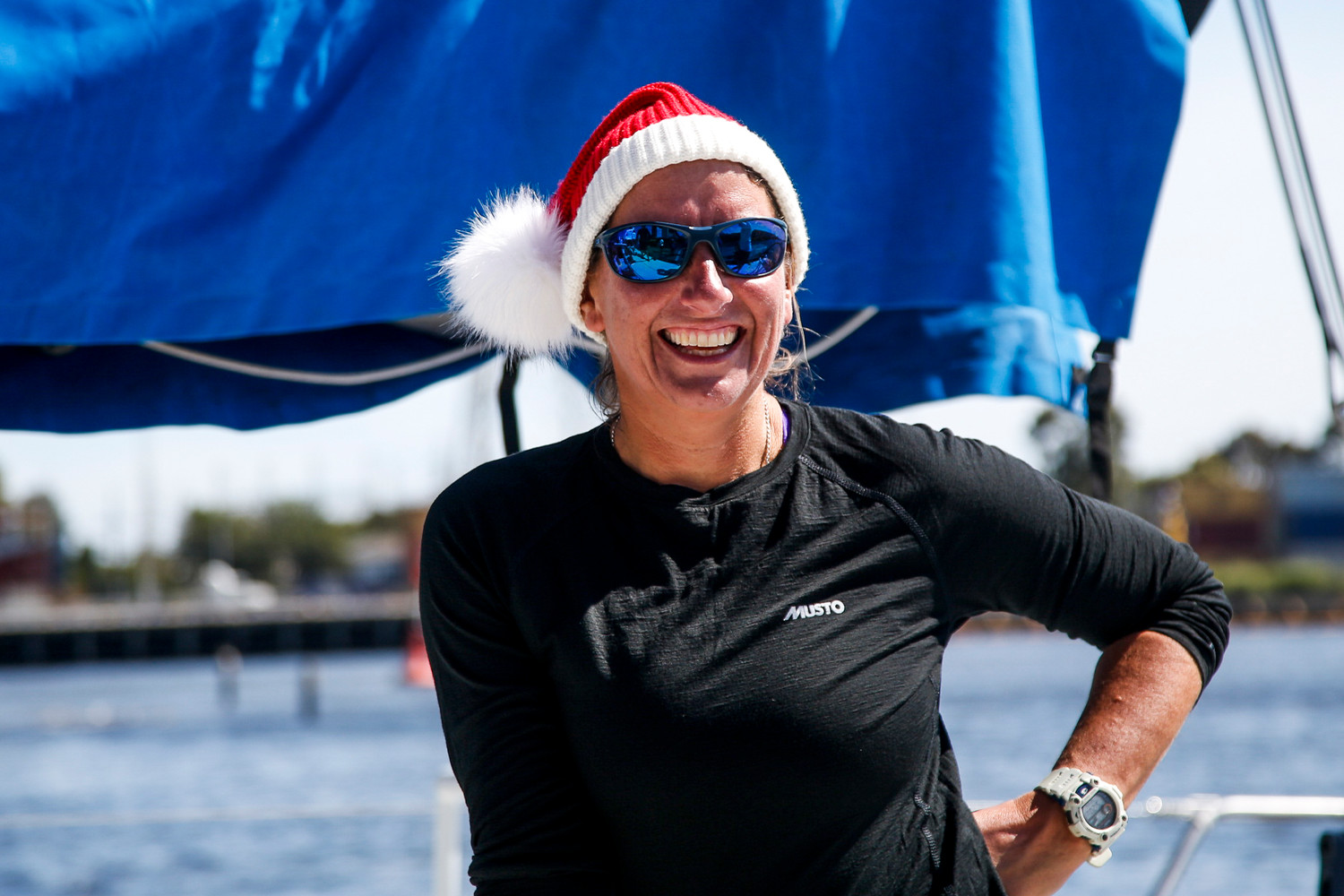
The departure from Cape Town was windy and varied, as we had anticipated, with a huge transition zone in the shadow of Table Mountain. Although we had a poor start line up and were late, we worked hard at a reach to the first mark and got back in the game, controlled Akzo at the second mark and made gains to sail into the back of the fleet.
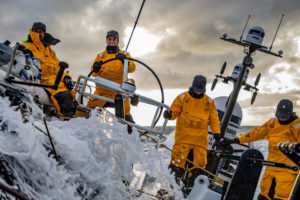
The fleet stayed together right up to the leaving gate with everyone hoisting a new sail before the wind died. We changed to the J0 ready for the wind change and also had the J1 plugged in. By looking at the water and the boats ahead we were able to deal with the transitions better than most and left the bay in the leading pack alongside Mapfre. We headed into upwind sailing with reefs going in the mainsail and the J2 as it started to get bouncy. As darkness descended, we started to tack into the shore playing the left to be on the right side of the shift.
Once we tacked as a fleet along the coastline, we then changed mode to sail south offshore to catch the new breeze. However, there was another transition first as we found ourselves in light winds the next morning making our way to the next weather. Our focus was now on the secondary low building and heading for us. The forecast was for winds in excess of 50 knots and 10 metre seas, so we needed to make a decision. As a team, we elected to remain in conditions that allowed us to sail and avoid the boat breaking conditions that would have put us in survival mode.
This was a conservative choice and a really tough call, however, we feel it was the right one for us. To avoid the worst of the weather we took the northern route which meant sailing extra miles and working hard to claw our way back to the fleet. A few days later we crossed in front of Scallywag and were just 30 miles behind Brunel. We had no damage (boat or sailors) and the crew had grown in confidence; it was a decision that worked for us but now the hard work began again sailing with the fleet.
We struggled to keep pace with everyone and I began to think that maybe we were better at sailing on our own! We lost miles to the fleet and there was a great deal of frustration on board. In addition, the ice exclusion zone was moved more north and this altered our tactics and meant we had some difficult sailing to deal with.
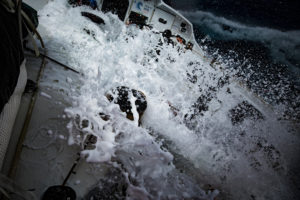
The company employed to monitor the ice and allow us to race as safely as possible had detected ice and the ice gate was duly moved to accommodate this. The impact of this was to create quite a challenge. With a limit to the south of us and a high pressure to the north, we were left with a very narrow corridor to sail which resulted in a full 36 hours of multiple gybes along the ice gate. Coming off the back of standby watches and gybing every 30 minutes or so meant I had a very tired crew and smiles were hard to come by – extremely unusual for the team. It didn’t help that throughout this time we were losing out to AzkoNobel behind us and Scallywag ahead of us and couldn’t work out why. Suddenly we hit the good wind, made gains in both the race and with morale onboard. Smiles were back in fashion!
Around about this point, talk turned to Christmas at sea, what the crew would miss and when we anticipated we would arrive into Melbourne. It looked like we had one more big blow to go then a fat high pressure between us and our festive destination.
Having the final ice exclusion zone to get past was tricky but we had good wind direction which helped us get by in just four gybes, which was a good outcome both for the wind speed and crew exhaustion. Now we were off again heading south east to the cold for about 800 miles. This was fast sailing and, as the wind speed increased, we were back with a reef and the FR0 sending it as fast as we could. We made some good gains on Scallywag and left AkzoNobel behind in different pressure negotiating the ice limit.
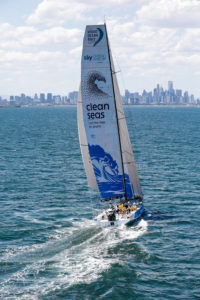
We were heading to 49 degrees south with a sea temperature of between 6 and 7 degrees and the air temperature similar. It was icy cold on deck and everyone was feeling the fatigue from being hosed down the deck for a four hour watch in those temperatures. Although sleep was much needed to recover, rest and warm up, it was really hard to come by due to the violent boat motion.
We had been decreasing the miles to Melbourne but it had reached the point where it had become quite depressing being on the non-making gybe. Eventually it was our time to gybe and, although the routing suggested we go further, we decided to go for it at the same time as Scallywag. They were now 80 miles ahead of us in a straight line but only 40 miles ahead to the finish – this was our battle to the finish line.
It was us and the Scally’s making similar speeds and courses, sailing as fast as possible to Melbourne. The entrance to Melbourne is a narrow channel width of just one mile with very shallow water and strong tides. The forecast was for light winds so we needed to make the most of the final strong winds for this leg before we hit the channel.
We were on schedule Christmas Eve when we had a huge wipe out and Chinese gybed. It is inevitable that this will happen out here from time to time but it is always a shock to everyone when it does. The team were calm and managed to recover the situation really well. With sails and sailors in one piece, we got back on track and were off again. Shortly after this we changed sails to a bigger one and hoisted to a full main. It was a case of go hard or go home and we only had two days left out there to make a difference.
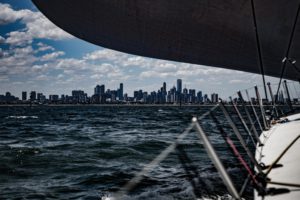
Christmas Day provided conditions under 10 knots as we transitioned round the edge of a high-pressure system. This brief respite allowed us, the boat and the equipment to dry out a little and enjoy a few surprises from Father Christmas. However, with just 12 miles between Scallywag and us and with light winds forecast we felt we still had an opportunity to catch them and so it was full blast to Melbourne. Sadly, the weather had other ideas and on Boxing Day morning we entered the Heads in a fickle, light winds with Scallywag too far ahead to catch and a big bay to cross to the finish line.
We ended the epic leg 3 in 6th place with the boat and sailors in one piece. I am so proud of our team and, yet again, I have watched them develop before my eyes. They have now seen waves and winds they had never experienced before and have been driving and dealing with the cold and wet really well. We have been on the pace with the fleet and have shown again the doggedness of a team that never gives up. Our time will come, of that I am sure.
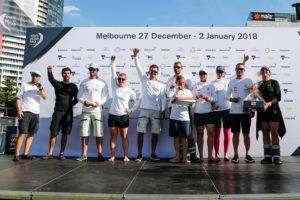
The success of this leg would not have been achieved without the help and support from those around us and I have to say a huge thank you to the guys with me who had prior experience in the South. Liz, Martin and Elodie were fantastic and supported me and the team through a tough 7000 miles. A little TLC will now be required for both the crew and the boat but nothing that will stop us racing to Hong Kong on the 2nd January!